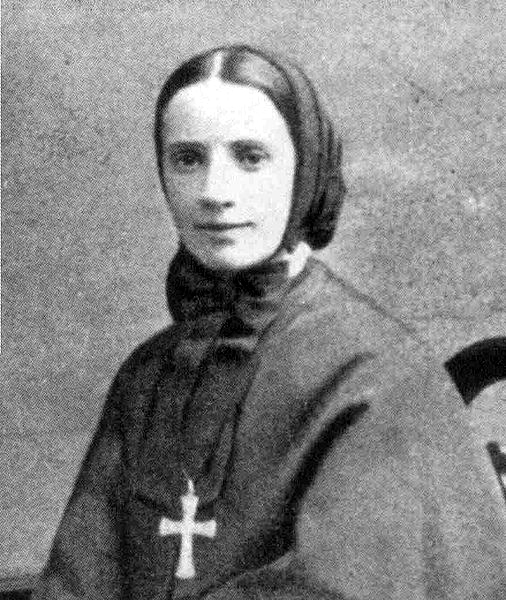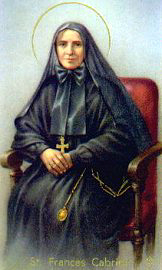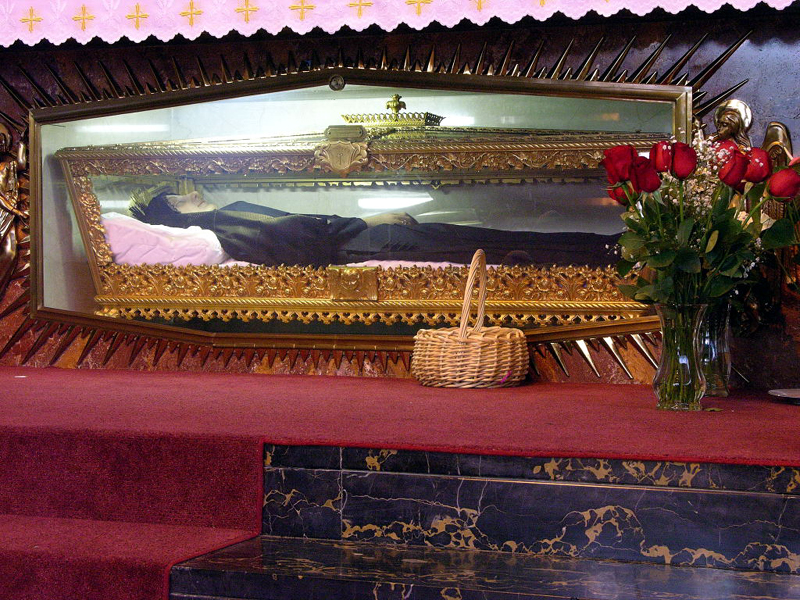Mother Cabrini
Agostino Cabrini and Stella Oldini were poor cherry tree farmers in the town of Sant’Angelo Lodigiano in the Lombardy region of northern Italy.
They had thirteen children. Sadly, only four of them survived beyond adolescence. One of these, the youngest, was a daughter named Francesca,
born two months prematurely, on July 15, 1850. On the day of her birth a mysterious event occurred. A flock of white doves came down from the
sky onto her father's land. Agostino tried to fight them off but managed to injure one of them. He tended to the dove's wounds and when it had
recovered, set the bird free. Since this was such an unusual event, the family thought of little Francesca as their "little dove." Small
and weak as a child, she remained in delicate health throughout her 67 years. This was all the more amazing considering the things she achieved
during her life.
Francesca's sister Rosa, who was fifteen years older, was the town's schoolmistress. It was under her sister's tutelage that Francesca received her primary education.
It was Rosa who instilled on her such values as humility, modesty and obedience. When she turned thirteen, she took a vow of virginity which she continued to do annually
and was made permanent when she reached the age of eighteen.
In 1877, when she was 27 years old, Francesca entered a convent, where she became a teacher and the mother superior of an orphanage in Codogno, Italy.


In 1880, the orphanage was closed. Not to let this discourage her, Mother Cabrini and six other nuns founded the Missionary Sisters of the Sacred Heart of Jesus (MSC) on November 14 of that year. Mother Cabrini composed the rules and constitution of the order, and she continued as its superior-general until her death. The order established seven homes and a free school and nursery in its first five years. At this time, she felt very strongly that her mission was to travel to China to continue her missionary work there. But Pope Leo XIII had other plans for her. He wanted to send her to America to help the Italian immigrants there who had lost their spiritual connection to the church. At first Mother Cabrini argued that she could do more service to the church by going to China, but the Pope admonished her by saying, "Not to the East, but to the West.".
On March 31, 1889, along with six other sisters and a thousand Italian immigrants, Mother Cabrini arrived in New York City. This was a frightening change of pace for the sisters and Mother Cabrini because it was nothing like their home in Codogna. New York was the same bustling city it is today and the traffic and fast paced activity surrounding them was overwhelming. It was a place where the newly arrived Italians could easily forget their religion and it was up to the nuns to guide them back on the path to God.
Unfortunately, the beginning of the trip did not go as planned due to the search at Ellis Island they were required to go through but also because the house they were to be staying in to start their mission did not exist. The first night there, they stayed in a filthy apartment in the Italian slum. The frightened, though courageous women stayed awake all night rather than sleep in the dirty beds. The next morning more bad news followed when they were told that the school they were to start was not prepared due to the tenants still inhabiting the building which needed to be repaired. Also, the missionaries' stipends that they were supposed to receive for the school were not available either, making a difficult trip worse. Mother Cabrini was in a city where she knew no one, did not know how to speak the language, yet she would not give up.
Her original mission was to start a new school and an orphanage for the homeless immigrant children in New York. The city's Archbishop, Michael Corrigan, who was not completely supportive, told the sisters to abandon any idea of opening an orphanage and to just concentrate on the school. He did however, manage to find them housing and placed them at the convent of the Sisters of Charity. They were permitted to stay there as long as was necessary. Quickly the sisters began to work going out and introducing themselves to the community and working within the parish located on 59th Street. The Italian immigrants enjoyed having the sisters in their community and it also helped to reinforce their religion. There were very few Italian priests in New York and, apparently, no nuns. Most of the immigrants did not speak English so it made it difficult to attend mass when nothing was understood. Many of the immigrants had not gone to confession for years and some had not attended mass for over two or three decades. This saddened Mother Cabrini and she knew her mission was clear and she was not one to let things go unattended.
One major benefactress was the Countess of Cesnola who contributed greatly to the restoration of faith in the Italian community. The Countess was kind enough to donate a large building in the wealthier section of town. On Palm Sunday of 1890, an orphanage was established. Part of this orphanage would be used for the sisters as a convent and the other would be for the homeless and underprivileged children in New York. On May 3, 1890 the first mass at the Sacred Heart chapel was prepared and Monsignor Corrigan, who was originally skeptical, read the mass. To this day this chapel is considered the first American motherhouse of the Missionary Sisters of the Sacred Heart. A little over a month later on June 29, 1890 the first batch of orphans arrived at the Sacred Heart orphanage.
Mother Cabrini was a devout Catholic with a good head for business. Nothing ever stopped her from receiving what she wanted. According to a nun who worked with her, Sister Ursula, "She had piercing blue eyes, a ready smile and a soft voice."
She was naturalized as a U.S. citizen in 1909. On December 22, 1917, while preparing Christmas candy for the local children, she died of complications from dysentery at age 67, in Columbus Hospital in Chicago, Illinois. By that time, she had founded 67 missionary institutions (matching the 67 years of her life) to serve the sick and poor and train additional nuns to carry on the work.

For all of her good work and deeds, the active, selfless, courageous, loving and obedient Mother Cabrini became Saint Frances Xavier Cabrini on July 7, 1946, the first American citizen to be canonized by the Roman Catholic Church. The canonization process is extremely difficult and very expensive. It usually takes about fifty years to pass the approval of a canonization. Also, two miracles, fully authenticated, are required by the Church before the process toward canonization. One of the miracles offered for Mother Cabrini was the restoration of sight to a newborn baby who had been blinded by an overdose of nitrite of silver solution. The child was believed to be beyond medical aid. After the sisters prayed to Mother Cabrini for his cure, the child recovered. A second miracle was the curing of a sister who was only given a day or two to live. However, after praying to Mother Cabrini she too, was cured and continued to live for another twenty years. These two miracles helped in the canonization of this Patron Saint.
Her body is enshrined under glass in the altar at the Saint Cabrini Shrine located in Mother Cabrini High School, in the Washington Heights section of northern Manhattan. It is actually just her body with a head made of wax. Her head is enshrined in Italy.

Saint Cabrini Shrine

Mother Cabrini enshrined under glass in the altar at the Saint Cabrini Shrine.
Sources: Jennifer McCabe of Fordham University, and Wikipedia.